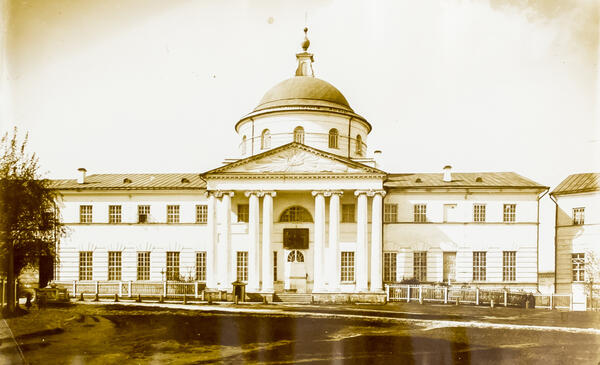In the early 20th century, an unknown photographer took a picture of the St. Nicholas of Tula Church.
There is information that the first church was located not far from the place where the Kazan icon of the Mother of God appeared. This is known from the “Tale of the Kazan Icon of the Mother of God”, which was compiled by Saint Hermogenes in 1594 — he was the Kazan Metropolitan at that time.
The saint said that as soon as the little girl Matrona found the icon, Archbishop Jeremiah ordered to take the relic and pray in “the church of St. Nicholas, whose name is Tulsky.” Unfortunately, the author did not provide any information about the builders or the time of construction. Historians only know that later it became a side-chapel at the Holy Life-Giving Trinity church.
In the late 18th century, parishioners almost stopped visiting this temple. Therefore, in August 1810, by order of the emperor, the building of the second stone church in the name of St. Nicholas of Tula began. It was erected on the territory of the Mother of God Monastery. In 1816, the building was consecrated by the Archbishop of Kazan and Sviyazhsk Ambrose.
The new building had four chapels: on the right side at the entrance to the temple — in honor of the Savior Not Made by Hands; on the left — in honor of the Kazan saints Guriy, Barsanthius and Herman; in the choir on the right side — in the name of the Martyr Margaret and the Desert Mother Mary of Egypt; on the left — in the name of John the Baptist. The structure was crowned with one dome.
The church was made warm: that is, in the winter time it could be heated and people could come there to worship. Therefore, next to the iconostasis, the builders created an additional place for the most important relic of the monastery — the main Kazan icon of the Mother of God. The priests stored it there during the cold season. In the same church, another revered image was kept — a copy of the Tula icon of St. Nicholas the Wonderworker. In addition, there were ancient copies of the Savior and the Mother of God of Smolensk, which Tsar Fyodor Ioannovich himself sent to the monastery in 1595, as well as another copy from the Kazan icon.
The photograph shows this temple about a century after its consecration.
There is information that the first church was located not far from the place where the Kazan icon of the Mother of God appeared. This is known from the “Tale of the Kazan Icon of the Mother of God”, which was compiled by Saint Hermogenes in 1594 — he was the Kazan Metropolitan at that time.
The saint said that as soon as the little girl Matrona found the icon, Archbishop Jeremiah ordered to take the relic and pray in “the church of St. Nicholas, whose name is Tulsky.” Unfortunately, the author did not provide any information about the builders or the time of construction. Historians only know that later it became a side-chapel at the Holy Life-Giving Trinity church.
In the late 18th century, parishioners almost stopped visiting this temple. Therefore, in August 1810, by order of the emperor, the building of the second stone church in the name of St. Nicholas of Tula began. It was erected on the territory of the Mother of God Monastery. In 1816, the building was consecrated by the Archbishop of Kazan and Sviyazhsk Ambrose.
The new building had four chapels: on the right side at the entrance to the temple — in honor of the Savior Not Made by Hands; on the left — in honor of the Kazan saints Guriy, Barsanthius and Herman; in the choir on the right side — in the name of the Martyr Margaret and the Desert Mother Mary of Egypt; on the left — in the name of John the Baptist. The structure was crowned with one dome.
The church was made warm: that is, in the winter time it could be heated and people could come there to worship. Therefore, next to the iconostasis, the builders created an additional place for the most important relic of the monastery — the main Kazan icon of the Mother of God. The priests stored it there during the cold season. In the same church, another revered image was kept — a copy of the Tula icon of St. Nicholas the Wonderworker. In addition, there were ancient copies of the Savior and the Mother of God of Smolensk, which Tsar Fyodor Ioannovich himself sent to the monastery in 1595, as well as another copy from the Kazan icon.
The photograph shows this temple about a century after its consecration.



